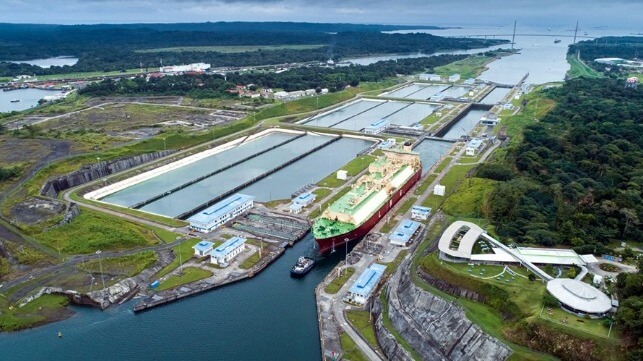Panama Canal Further Lowers Transits Impacting Largest Ships

The Panama Canal Authority is taking a further series of steps that include reducing the number of daily transits for the largest vessels using the canal as they continue to be confronted by a prolonged drought. Further, they warned while adjusting the reservation system that the draft reduction “will very likely remain in effect throughout the 2024 dry season.”
Releasing its Fiscal Year 2024 Update at the end of last week, the Panama Canal Authority highlights that water levels in the Gatun Lake system which feeds that canal and provides drinking water to approximately 50 percent of the country’s population remains low. The Gatun Reservoir has fallen from a peak of over 88 feet in December 2022 to just over 79 feet as of June 2023. It has remained between 79 and 80 feet since then.
“Transits will be adjusted to 31 transits per day,” the ACP advises. While that is only a reduction of one transit on average per day, they have decided to take the reduction for the first time at the bigger Neopanamax locks which serve the largest ships, primarily container vessels and gas carriers. Previously they had highlighted that they were maintaining the larger locks at 10 transits daily while the 44-foot draft restriction already meant that the largest vessels were often required to offload boxes to be transshipped across the Isthmus. The 44-foot restriction will be maintained but in addition to reducing the number of daily transits, they are also advising that Panamax plus vessels will not be allowed to transit in the Neopanamax locks. These ships will instead need to comply with the 39.5-foot draft restrictions and transit the Panamax locks.
The change is going into effect on November 1. Since August the canal was averaging 32 transits each day, down from normal operations of 36 to 38 daily transits. The lowering of the number of transits was done to maintain the 44-foot draft, which the authority says is required by 70 percent of the ships transiting the canal. The draft is down from a peak of 50 feet before the drought restrictions.
Sensitive that the prior reductions have resulted in long backlogs, the canal authority is also adjusting the reservation system to a maximum of 30 booking slots a day, holding one slot in the Neopanamax locks open for vessels without reservations. During October, however, reservations are being limited to just 14 to give vessels a chance to adjust their schedules and further clear the backlog which currently stands at 93 vessels. The authority highlights a year ago 97 vessels were waiting for transit saying that its goal is to provide transits “within reasonable timeframes.”
The further restricting the number of transits comes as the Panama Canal could see an increase in the number of vessels seeking passage. LNG shipments could rise with the closer winter months for countries ranging from China, Japan, and South Korea which are large imports as well as in Europe. Container volumes are also forecast to slowly rise on major trade routes and cruise ships which were on a seasonal hiatus typically return to the Panama Canal in October and November and into the winter months in North America.
The one good piece of news is that the lower draft means that the variable component of the Fresh Water Surcharge was also lowered effective October 1. The fee applies to all vessels over 125 feet in length transiting the canal. They will be receiving some financial relief on their fees due to the lower water levels.
The Panama Canal Authority highlights that it is taking steps to maintain the flow of commerce with short-term measures. They have predicted that the canal’s revenues could decline by as much as $200 million in the year that began on October 1 due to the restrictions but note that the number of vessels using the canal remains high. They are also working on long-term water management efforts to address the impact of climate change and maintain operations.
